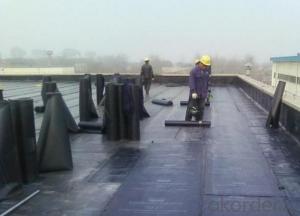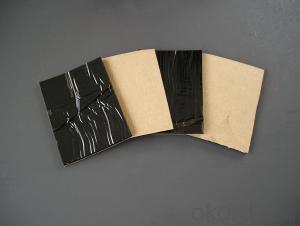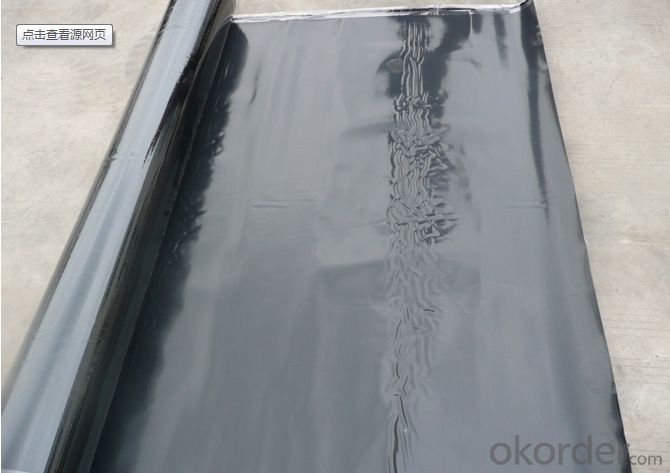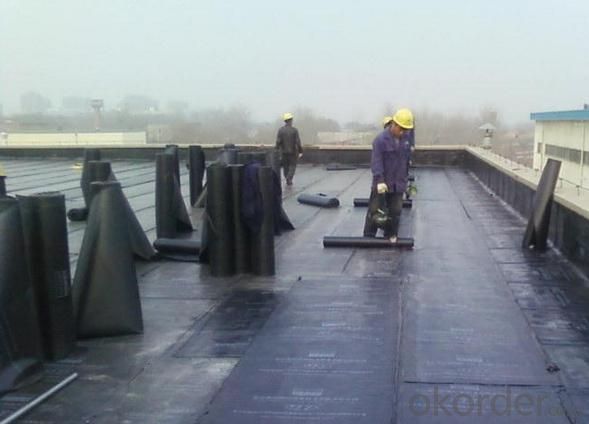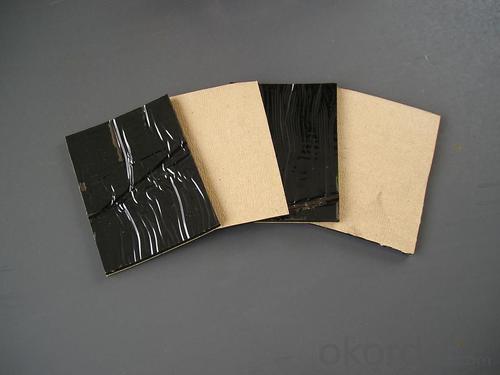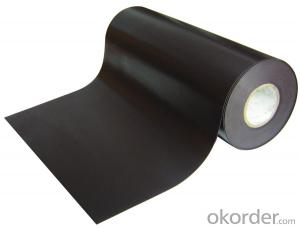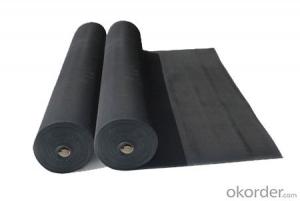EPDM Weldable Waterproofing Membrane Underground Protection
- Loading Port:
- China main port
- Payment Terms:
- TT OR LC
- Min Order Qty:
- 5000 m²
- Supply Capability:
- 100000 m²/month
OKorder Service Pledge
OKorder Financial Service
You Might Also Like
Introduction for EPDM Waterproofing Membrane:
Waterproof membrane for roof adopt the international advanced level cold feed extrusion continuous vulcanization process for the integration of production equipment and technology so that the system density of products is better and the products have no bubble sooth surface, no performance difference between vertical and horizontal.
Application of EPDM Waterproofing Membrane:
EPDM waterproof membranes form an effective barrier to liquid water or water vapor in the roof construction for industrial and civil engineering, underground engineering such as subway & tunnel, water conservancy such as water pools & ditch, shelter, grain depot, land filling, dyke and subwayt.
Specification of EPDM Waterproofing Membrane:
No. | Item | Unit | Standard Request | |
1 | Variation in Dimension | Thickness | % | ±10 |
Width | % | ±1 | ||
Length | % | No Negative Value | ||
2 | Tensile Strength at Break(Normal Temperature) | Mpa | ≥7.5 | |
Tensile Strength at Break(60ºC) | Mpa | ≥2.3 | ||
3 | Elongation at Break(Normal Temperature) | % | ≥450 | |
Elongation at Break(-20ºC) | % | ≥200 | ||
4 | Tearing Strength | KN/m | ≥25 | |
5 | Water Impermeability(30min) | * | 0.3Mpa Impermeability | |
6 | Bend Temperature | ºC | ≤-40 | |
7 | Heating Expansion/Shrinkage | Expansion | mm | ≤2 |
Shrinkage | mm | ≤4 | ||
8 | Hot Air Aging 80ºC x168h | Unchanging of Tensile Strength at Break | % | ≥80 |
Unchanging of Tearing Strength | % | ≥70 | ||
9 | Property of Anti Alkali 10% Ca(OH)²x 168h normal temperature | Unchanging of Tensile Strength at Break | % | ≥80 |
Unchanging of Tearing Strength | % | ≥80 | ||
10 | Elongation 40%,500x102 | * | No Crack | |
11 | Artificial Aging | Unchanging of Tensile Strength at Break | % | ≥80 |
Unchanging of Tearing Strength | % | ≥70 | ||
Appearance of 100% elongation | * | No Crack | ||
Product Features
A.Polyester based SBS Modified Bitumen Waterproofing Membrane
a. Strong impermeability
b. High tensile strength, elongation, ability to adapt the grassroots shrinkage deformation and cracking
c. Puncture-resistant, broken resistant, tear-resistant
d. The corrosion resistance, resistance to mildew, weathering good
e. Construction convenient, hot-melt can be operated Four Seasons Construction, reliable joints
B. Fiberglass based SBS Modified Bitumen Waterproofing Membrane
a. High tensile strength, stability of a good size
b. High Temperature good performance
c. Damage resistance, corrosion resistance, resistance to mildew, weathering good performance
d. Good construction performance, reliable joints.
FAQ of Waterproofing Membrane
a.Can we get some samples before place order?
Answer: We can send the free samples to you by freight collect.
b.How many years can your PVC membrane guarantee?
Answer: We will guarantee the quality for 5 years at least.
c.Which countries you ever export the product?
Answer: We export the PVC membrane to South Africa, Middle east and even European countries.
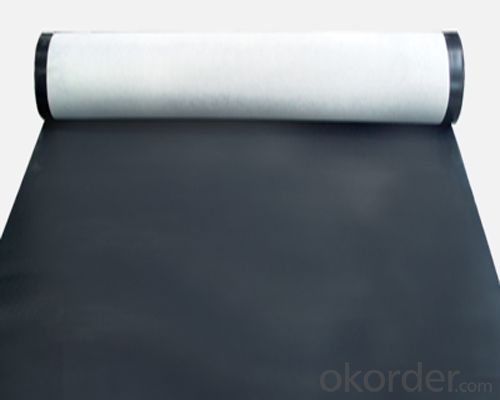
- Q: How does a waterproofing membrane perform in areas with chemical exposure or solvents?
- Waterproofing membranes are not specifically designed to resist chemical exposure or solvents. Although they may offer some resistance to certain chemicals, extended exposure to aggressive chemicals can compromise their effectiveness. These chemicals can degrade the membrane material over time, making it brittle, cracked, or ineffective at waterproofing. To improve the performance of a waterproofing membrane in areas with chemical exposure or solvents, it is advisable to use a specialized chemical-resistant membrane. These membranes are made from tested materials that can withstand various chemicals and solvents. They provide a higher level of protection and durability, ensuring long-lasting performance and preventing damage caused by chemical exposure. It is important to choose the appropriate waterproofing membrane based on the specific chemicals and their concentrations present. Seeking guidance from a professional waterproofing contractor or manufacturer can help in selecting the most suitable membrane for the intended application. Regular inspection and maintenance are crucial to monitor the performance of a waterproofing membrane in areas with chemical exposure. Promptly addressing any signs of deterioration, such as cracks, leaks, or discoloration, can prevent further damage and potential water infiltration. Overall, while a waterproofing membrane can offer some protection in areas with chemical exposure or solvents, it is preferable to use a specialized chemical-resistant membrane for superior long-term performance and durability.
- Q: Can a waterproofing membrane be used for a warehouse floor?
- No, a waterproofing membrane is not typically used for a warehouse floor. Instead, materials such as epoxy or concrete sealers are commonly used for warehouse floors to provide durability and resistance to heavy loads and foot traffic.
- Q: Can a waterproofing membrane be used in areas with high levels of salt or saltwater exposure?
- Yes, a waterproofing membrane can be used in areas with high levels of salt or saltwater exposure. Waterproofing membranes are designed to provide a protective barrier against moisture, including saltwater. They are often used in coastal regions, marine environments, or areas with high salt content in the soil to prevent water damage and corrosion.
- Q: Sbs modified asphalt waterproof membrane polyester type Ⅰ type Ⅱ how to distinguish
- These two kinds of materials from the current surface is exactly the same, if it is experienced people, you can through the tension on the sheet asphalt to determine the initial situation, if the domestic refrigerator can reach -25 ℃ low temperature, can also be low temperature flexibility Not broken after the initial judgment). To correctly determine the need for sample inspection.
- Q: Can a waterproofing membrane be used for warehouses or storage facilities?
- Yes, a waterproofing membrane can be used for warehouses or storage facilities. Waterproofing membranes are designed to protect structures from water damage by providing a barrier against moisture infiltration. Warehouses and storage facilities typically have large areas that are exposed to potential water leaks or seepage, such as roofs, walls, and floors. By installing a waterproofing membrane, these structures can be effectively protected from water intrusion, preventing damage to stored goods and preserving the integrity of the facility. Waterproofing membranes are available in various types, such as bituminous, liquid applied, or sheet membranes, allowing for flexibility in choosing the most suitable option based on the specific needs of the warehouse or storage facility. Additionally, waterproofing membranes can also provide additional benefits such as thermal insulation and resistance to chemicals, making them a valuable choice for ensuring the longevity and functionality of warehouses or storage facilities.
- Q: Can a waterproofing membrane be used in conjunction with insulation materials?
- Yes, a waterproofing membrane can be used in conjunction with insulation materials. The membrane acts as a barrier to prevent water infiltration, while insulation materials provide thermal resistance to control heat flow. This combination is commonly used in construction to ensure both waterproofing and insulation performance.
- Q: Can a waterproofing membrane be used on roofs with solar panels?
- Roofs with solar panels can indeed incorporate a waterproofing membrane. In fact, it is strongly advised to utilize a waterproofing membrane in these instances to guarantee the roof's integrity and fend off any potential leaks. The waterproofing membrane serves as a shield, preventing water infiltration into the roof structure and averting any harm. It is crucial to select a waterproofing membrane that harmonizes with the solar panels and does not impede their efficacy. Furthermore, proper installation methods must be adhered to in order to seamlessly integrate the membrane and solar panels.
- Q: Can a waterproofing membrane be used for solar panel installations?
- Yes, a waterproofing membrane can be used for solar panel installations. In fact, it is often recommended to use a waterproofing membrane as part of the installation process to protect the roof or other surfaces beneath the solar panels from water damage. A waterproofing membrane acts as a barrier to prevent water from seeping into the underlying structure, ensuring that the solar panel installation remains watertight and secure. This is particularly important as solar panels are typically installed on rooftops, where they are exposed to various weather conditions. By incorporating a waterproofing membrane, it helps to prolong the lifespan of the solar panels and prevents any potential water-related issues that could affect their performance.
- Q: Is a waterproofing membrane resistant to punctures or tears?
- A waterproofing membrane is created to resist punctures or tears, being made from robust materials like PVC, TPO, or EPDM, renowned for their strength and damage resistance. These membranes undergo extensive testing to ensure they can endure different environmental conditions and potential causes of punctures or tears, like sharp objects or heavy foot traffic. Some waterproofing membranes even have reinforcement layers or added protection to further strengthen their resistance to punctures and tears. Nevertheless, it is crucial to note that while waterproofing membranes are highly durable, they are not entirely immune to damage. Proper installation, regular maintenance, and avoiding unnecessary stress or impact on the membrane can help extend its lifespan and enhance its performance.
- Q: Can a waterproofing membrane be used on swimming pool decks?
- Indeed, swimming pool decks can benefit from the use of a waterproofing membrane. The purpose of these membranes is to effectively block water infiltration, which makes them particularly suitable for safeguarding areas that are constantly exposed to moisture, like swimming pool decks. Typically, these membranes are applied directly onto the deck's surface, creating an impermeable and long-lasting layer. This ensures that water does not permeate the deck, thus averting potential harm caused by dampness, such as cracks, the growth of mold, or structural decline. Furthermore, waterproofing membranes offer additional advantages, including prolonging the lifespan of the deck and enhancing its overall aesthetic appeal.
Send your message to us
EPDM Weldable Waterproofing Membrane Underground Protection
- Loading Port:
- China main port
- Payment Terms:
- TT OR LC
- Min Order Qty:
- 5000 m²
- Supply Capability:
- 100000 m²/month
OKorder Service Pledge
OKorder Financial Service
Similar products
Hot products
Hot Searches
Related keywords

